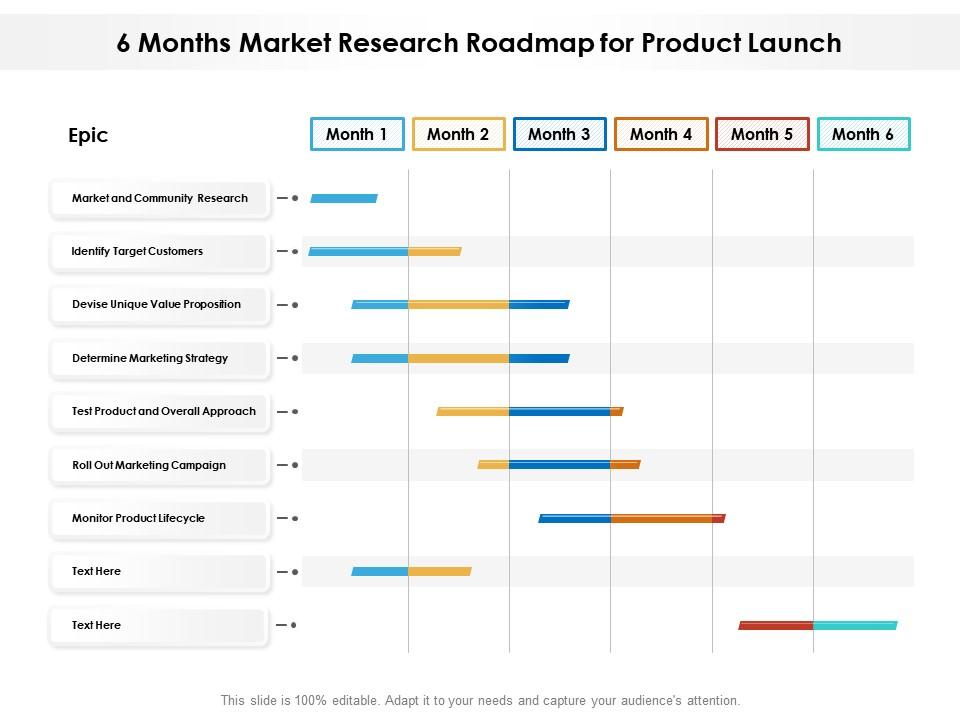After extensive testing and evaluation, we’ve identified the top product marketing tools. Our team of experts confidently recommends these as the most effective and user-friendly options for your next campaign.
As a product marketer, I often manage numerous tasks, and lacking a reliable toolset only adds to the stress.
But does it ever get easier?
Yes, it does! With the right product marketing tools, it becomes easy to effortlessly launch successful campaigns that drive massive traffic and streamline the sales funnel, turning leads into customers with ease.
However, over the years, I have seen that most people make mistakes when choosing a tool or wonder if these tools can benefit their business. Keeping this in mind, I have created this post explaining the features, benefits, best tools, and ways to choose the right one.
But before that, let’s quickly take a look at the tools:
| Product Marketing Tools | Best For | Pricing |
|---|---|---|
| Qualaroo | User & Customer Feedback Surveys via Website or App | Free plan available. Paid plan starts at $19.99/month |
| ProProfs Survey Maker | Easily Creating & Conducting NPS & CSAT Surveys | Free plan available. Paid plan starts at $9.99/month |
| Hotjar | Website Feedback with Surveys & Behavior Tracking | Free plan available(Track up to 35 daily sessions). Paid plan starts at $32/month |
| ProProfs Project | Planning, Collaborating & Delivering Projects on Time | Free for small teams; Paid plan starts at $39.97/month |
| UserGuiding | All-in-One Product Adoption Platform | Starts at $89/month |
| Smartsheet | Maximizing Portfolio Performance | Starts at $9/member/month |
| Figma | Prototyping | Free plan available (3 collaborative design files). Paid plan starts at $15/full seat/month |
| Miro | Remote Collaboration | Free plan available (up to 3 editable boards). Paid plan starts at $8/month/member |
| UserTesting | Delivering Winning Digital Interactions | Custom quote |
| Segment | Customer Acquisition | Custom quote |
| Survicate | Simple and User-Friendly Survey Creation | Free plan available (up to 25 responses/month). Paid plans start at $99/month |
| Trello | Engaging Product Marketing Templates | Free plan available (Up to 10 boards per Workspace). Paid plan starts at $5/user/month |
| Amplitude | Behavioral Analytics | Free plan available (Limited to starter templates only). Paid plan starts from $49/month |
| Asana | Accelerating Campaign Production | Free plan available (collaborate with up to 10 teammates). Paid plan starts at $10.99/month |
| BuzzSumo | Competitor Intelligence | Custom quote |
Which is the Best Product Marketing Software?
When choosing the best product marketing software, it’s essential to pick what suits your needs.
Here are my top three picks:
- Qualaroo: Ideal for real-time user feedback with its advanced reporting and Nudge™ technology. It supports over 100 languages and integrates with tools like Salesforce and MailChimp.
- ProProfs Survey Maker is perfect for effortlessly creating and managing NPS and CSAT surveys. It offers real-time analytics and integrates with CRM tools.
- Hotjar: Best for website feedback, combining surveys with behavior tracking. Its heatmaps and session recordings offer deep insights into user interactions.
If you want to explore these and the remaining tools in detail, do not forget to check the list discussed later in this post.
What is Product Marketing?
Product marketing is bringing a product to market and promoting it to potential customers. It involves understanding the product’s target audience, creating a compelling value proposition, and developing strategies to communicate the product’s benefits effectively.
Key components include market research, positioning, messaging, launching campaigns, and analyzing customer feedback. The goal is to drive demand and adoption of the product. This ensures it meets customer needs and stands out in the marketplace.
Why Trust Our Product Marketing Tools Reviews?
Since 2021, we’ve been dedicated to testing and reviewing product marketing software. As product managers, we know how important and tough it can be to pick the right tools.
We put much effort into researching to help our audience make smart software choices. So far, we’ve tested over 1,500 tools for various product management needs and have written over 800 detailed software reviews.
15 Best Product Marketing Software to Try in 2025
I have created this list based on my personal experience, peer recommendations, and through my own research.
1. Qualaroo – Best for User & Customer Feedback Surveys via Website or App
I recently used Qualaroo, and it’s a product marketing software for real-time customer feedback. The software provides advanced reporting, survey templates, and its NudgeTM technology for contextual feedback.
It supports over 100 languages and integrates with tools like Salesforce and MailChimp. Customizable surveys and AI-driven sentiment analysis make it versatile for medium to large businesses.
What You Will Like:
- Collects feedback without disrupting the user experience.
- Easy-to-use survey creation with diverse templates.
- Advanced reporting and AI sentiment analysis.
- Customization options and skip logic for targeted surveys.
- Integration with popular tools like Salesforce and MailChimp.
What You May Not Like:
- No downloadable or on-premise version
- The dark user interface option is not available
- No dedicated account manager for the free plan, unlike the paid
Pricing
A forever free plan for startups and small businesses with all premium features. Paid plan starts at $19.99/month.
2. ProProfs Survey Maker – Best for Easily Creating & Conducting NPS & CSAT Surveys
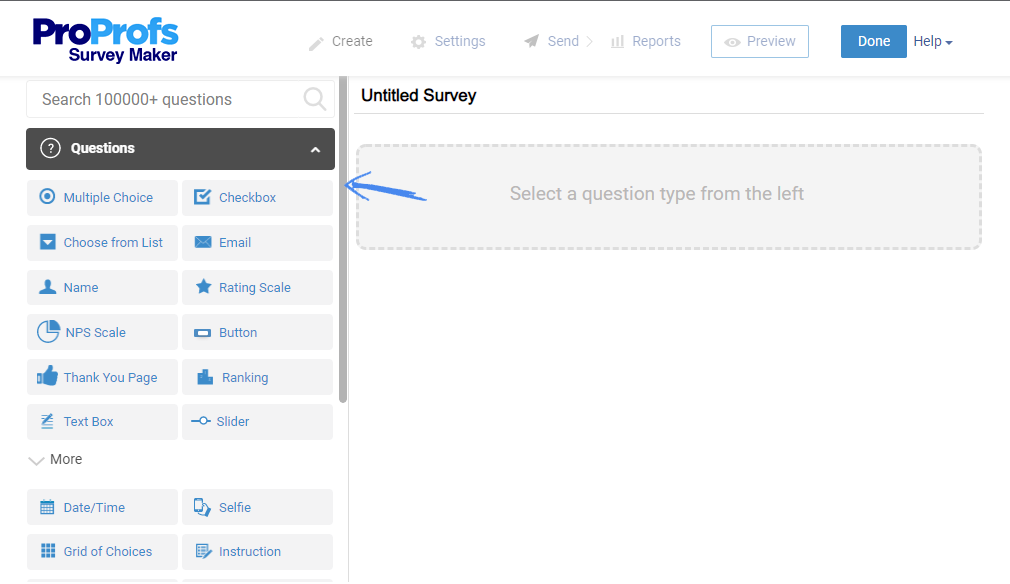
ProProfs Survey Maker stands out for creating and conducting NPS and CSAT surveys effortlessly. Its intuitive interface lets you quickly set up surveys, making it perfect for gathering valuable customer feedback.
The comprehensive analytics of this site feedback tool help interpret the results, guiding actionable improvements. It’s my go-to for understanding user satisfaction and loyalty, as it simplifies the entire process from survey creation to data analysis, making it indispensable for crafting an effective UX strategy.
What You Will Like:
- Offers a wide range of question types for diverse data collection.
- Provides real-time reporting and analytics for instant insights.
- Seamlessly integrates with CRM and email marketing tools.
- Supports multiple languages for a global audience.
- Features robust security with SSL encryption and data privacy controls.
What You May Not Like:
- No downloadable or on-premise version is available.
- The dark user interface option is not available
- No dedicated account manager for the free plan, unlike the paid
Pricing
Forever free basic plan. Paid plans start at $9.99/month. Unlimited surveys
3. Hotjar – Best for Website Feedback with Surveys & Behavior Tracking
Hotjar is one of the best tools for product marketing known for website feedback, blending surveys with behavior tracking. Its intuitive interface makes it easy to collect user insights through various feedback tools. Hotjar’s heatmaps and session recordings offer a visual understanding of user interactions, helping identify areas for improvement.
Additionally, its survey feature gathers direct user feedback, making it a comprehensive tool for optimizing website performance and user experience.
What You Will Like:
- Provides heatmaps and session recordings for detailed behavior analysis.
- Customizable surveys capture direct feedback from users.
- User-friendly interface simplifies survey setup and management.
- Integrates with other analytics tools for a complete picture.
- Supports multiple languages, catering to a global audience.
What You May Not Like:
- Slightly counter-intuitive interface
- Limitations in tracking the sessions
Pricing
Free plan available(Track up to 35 daily sessions). Paid plan starts at $32/month
Related Read: 15 Best Usability Testing Tools for an Effective User Experience Strategy]
4. ProProfs Project – Best for Planning, Collaborating & Delivering Projects on Time

ProProfs Project is a product management tool I started using earlier this year after hearing great things from a former colleague in a software development startup. Its intuitive interface makes it a breeze to navigate with no learning curve required, which is a huge plus for me. What stands out is its ability to streamline tracking of product development across various stages.
ProProfs Project offers different views like lists, calendars, Kanban boards, and Gantt charts, ensuring I always have a clear picture of project progress and deadlines. It’s a straightforward choice for startups and SMBs looking to manage product development efficiently.
What You’ll Like:
- Task dependencies to ensure projects are completed in order and on time.
- Management of multiple products from a single dashboard for streamlined workflow.
- Tracking of billable and non-billable hours for accurate client billing.
- Easy creation of reports and invoices to keep clients informed.
- Shared calendar for task allocation and milestone synchronization.
What You May Not Like:
- No downloadable or on-premise version
- Dark user interface option not available
- No dedicated account manager for the free plan, unlike the paid
Pricing
Starts at $0 for small teams. The paid plan starts at $39.97/month
5. UserGuiding – Best All-in-One Product Adoption Platform
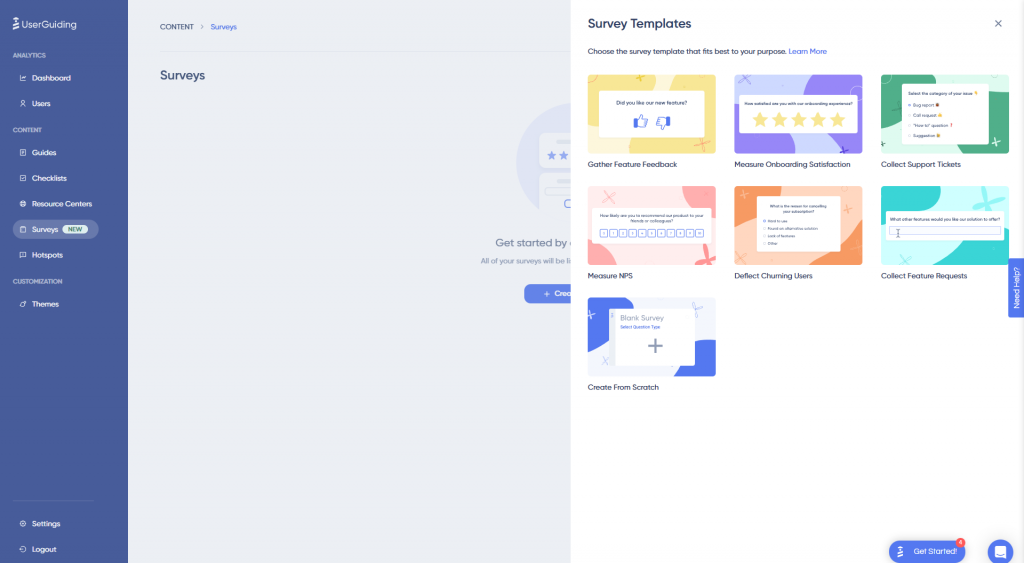
I’ve been using UserGuiding, and it’s a great tool for product adoption. It’s an all-in-one platform that makes onboarding users a breeze. The best part? You can create interactive product tours and tooltips without any coding skills. This has been super helpful for guiding new users through our product and ensuring they get the most out of it.
This software for product marketing makes it incredibly easy to create in-app experiences like product tours, tooltips, and modals without needing any coding skills. Setting up and implementing these features is quick—just a 15-minute setup, and you’re ready. Whether you’re looking to boost feature adoption or improve user engagement, UserGuiding’s straightforward approach and powerful features make it a top choice.
What You Will Like:
- Creating interactive product tours is so easy; no coding is needed.
- Real-time analytics help me keep track of how users are doing.
- The feedback tools give valuable insights for improving the onboarding process.
- It integrates well with other software I’m using.
- It’s accessible to everyone on the team, regardless of technical skill.
What You May Not Like:
- Customization options can be a bit limited for more advanced needs.
- There’s a bit of a learning curve to get the most out of all the features.
Pricing
Starts at $89/month
6. Smartsheet – Best for Maximizing Portfolio Performance
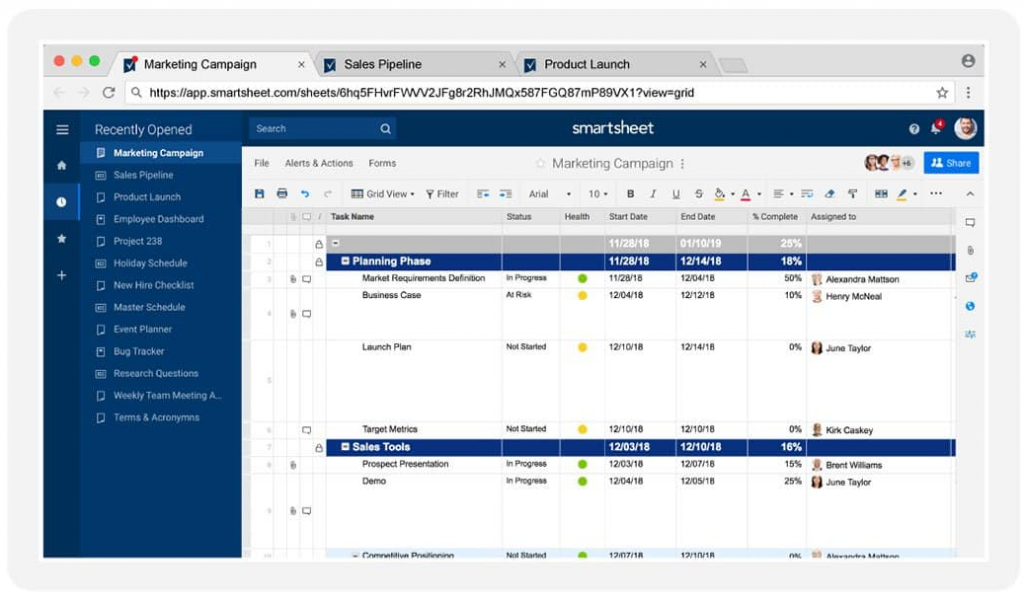
Smartsheet has been a game-changer for managing projects and portfolios with unmatched efficiency. This online product marketing tool connects strategy to execution, making complex product management feel like a breeze. Setting up and using Smartsheet is incredibly intuitive, allowing you to plan, align, and scale your products effortlessly.
The real-time visibility and robust reporting features keep you in control and ahead of the curve. Plus, its automation and seamless integrations with other tools eliminate tedious manual tasks, freeing up your time to focus on what matters.
What You Will Like:
- Automatically generate data visualizations, such as burndown and time series charts, to support better decision-making.
- Track team workloads and manage over-allocations to improve project execution.
- Get started quickly with customizable templates designed to streamline task management.
- Automate tasks with no-code workflows tailored to your needs.
What You May Not Like:
- Some advanced capabilities might take a bit of time to master.
- The cost might be steep for smaller teams or startups.
Pricing
Starts at $9/member/month
7. Figma – Best for Prototyping
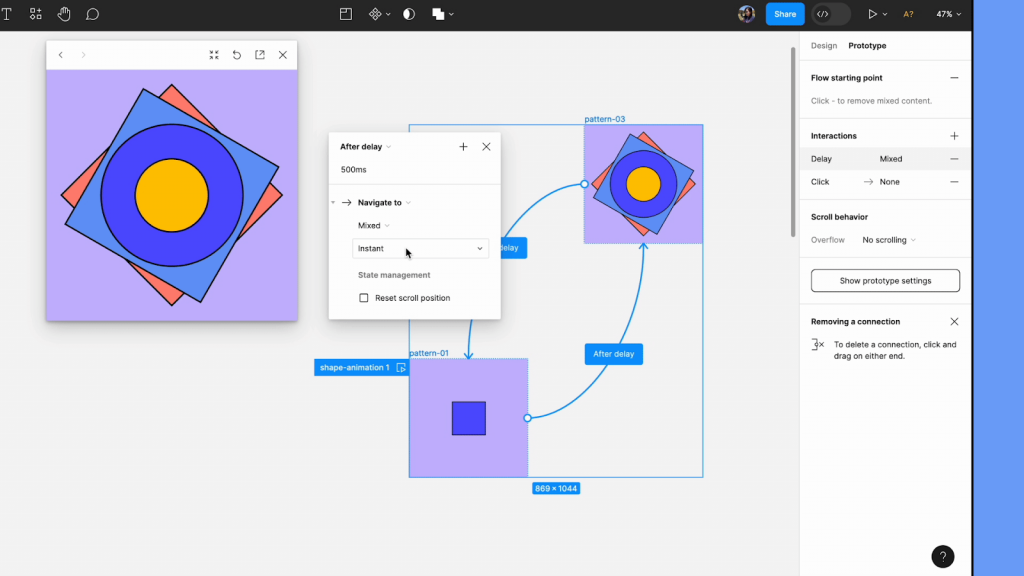
Figma is my go-to tool for quickly and effortlessly turning product design ideas into interactive, high-fidelity prototypes. I’ve been using Figma to create and share prototypes without writing a single line of code. The beauty of Figma lies in its ability to let you design and prototype all in one place, making the whole process smooth and intuitive.
The no-code approach means you can build realistic, interactive experiences that give developers a clear, actionable vision of your design. With features like smart animations, interactive components, and a responsive prototype viewer, Figma helps me bring complex interactions to life with ease.
What You’ll Like:
- Create animations and transitions effortlessly with smart interactive components.
- Prototype for any screen size and see how your designs adapt.
- Easily add GIFs and videos to simulate real user interactions.
- Work with your team in real-time, no matter where you are.
What You May Not Like:
- Some advanced features might take time to master.
- Prototyping with very large files or complex interactions might slow down the platform.
Pricing
Free plan available (3 collaborative design files). Paid plan starts at $15/full seat/month
8. Miro – Best for Remote Collaboration
Miro is the ultimate tool for remote collaboration and visualizing product management. Imagine a digital whiteboard where your team can brainstorm, plan, and strategize together, no matter where they are. With Miro, you’re not just working on ideas—you’re bringing them to life in real time.
It’s perfect for hosting interactive workshops, meetings with built-in video calls, and even digitizing those classic sticky notes we all love. Plus, Miro’s endless templates make it easy to visualize product roadmaps and agile workflows, turning complex ideas into actionable plans.
What You’ll Like:
- Extensive templates for product management tasks.
- Visual interface to manage and track project progress.
- Creative ideation tools like sticky notes, shapes, and mind maps.
- Ability to create low-fidelity prototypes and get early feedback.
What You May Not Like:
- The free plan lacks essential features like custom templates.
- Limited export/import options compared to other tools.
Pricing
Free plan available (up to 3 editable boards). The paid plan starts at $8/month/member
9. UserTesting – Best for Delivering Winning Digital Interactions
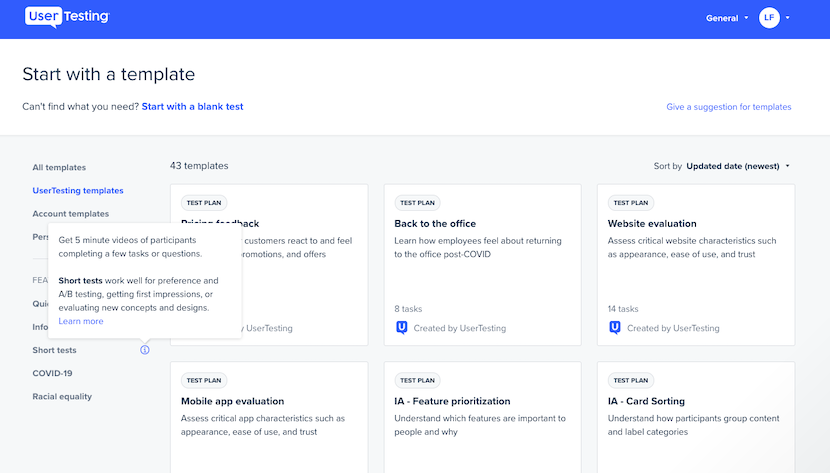
Although I haven’t used UserTesting, my research reveals that it’s a robust platform designed to help digital product teams deliver exceptional user experiences. UserTesting connects teams with real users in real time, enabling them to gather critical feedback throughout the entire product lifecycle.
This online product marketing offers various templates to streamline the discovery of user needs, validate concepts, and ensure alignment with customer expectations. It also helps mitigate risks by testing with target audiences, discovering customer frustrations, and learning about diverse user perspectives.
What You Will Like
- Supports testing with a large user base, helping teams gather comprehensive insights.
- Provides instant reactions from users, which accelerates decision-making processes.
- Allows testing across diverse user groups to understand varying needs and preferences.
- Facilitates cross-team collaboration by integrating feedback directly into design workflows.
- Integration with popular design tools like InVision, Figma, and Adobe XD.
What You May Not Like
- The complexity of the platform might be overwhelming for smaller teams or newbies.
- Users might need time to get accustomed to the full range of features and integrations.
Pricing
Custom pricing
10. Segment – Best for Customer Acquisition
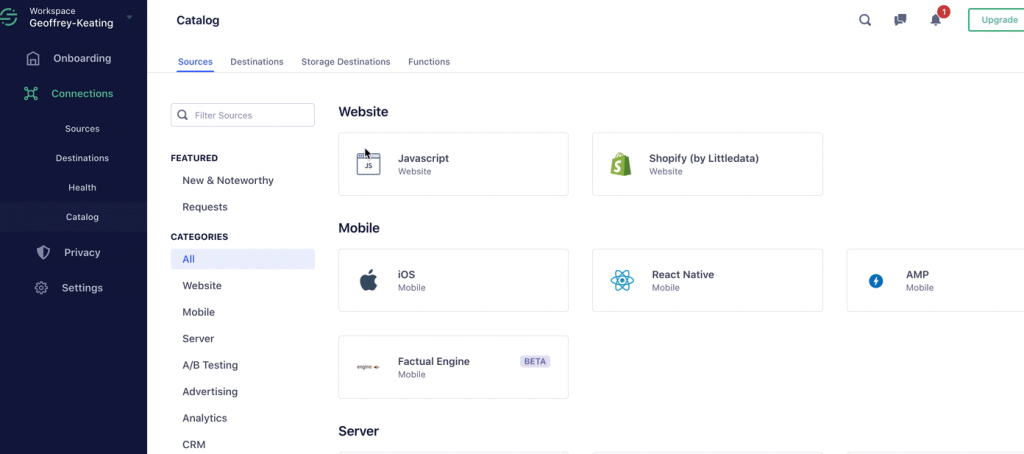
Ever wondered how to make your customer interactions work harder for your growth? Check out Twilio Segment! Based on my research, it’s a top tool for smartly acquiring new customers. Segment makes it easy to use customer data to create personalized and timely marketing campaigns that boost conversions and cut costs.
The platform helps you build real-time customer profiles so your marketing is always relevant. It also automates data management, saving time and speeding up insights. With a strong focus on first-party data, Segment helps you stay effective in marketing while keeping up with privacy rules.
What You Will Like
- Efficiently utilizes real-time customer profiles to deliver personalized marketing campaigns.
- AI-driven Predictive Audiences enable precise targeting, enhancing return on ad spend (ROAS).
- Simplifies data management with automated activation.
- Provides tools for future-proofing digital strategies in a cookieless environment.
What You May Not Like
- The platform might have a learning curve for those new to customer data management.
- Some integrations with less common platforms may be limited, which could impact data synchronization.
Pricing
Custom pricing
11. Survicate – Simple and User-Friendly Survey Creation
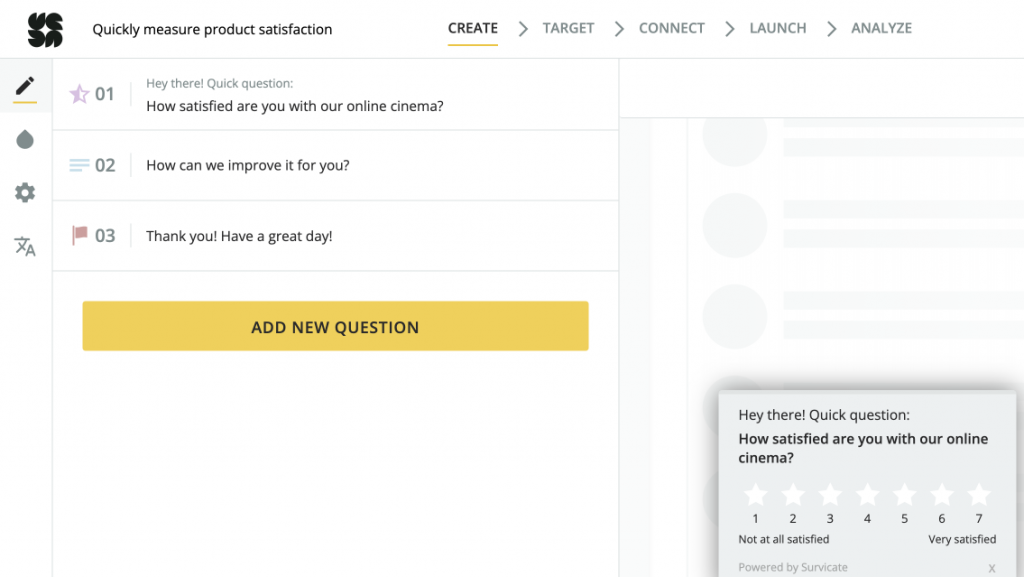
Ever wish you could get customer insights quickly and easily? Survicate is one of the best marketing tools you might need. I have used it, and I can confidently say that it is an efficient platform for gathering valuable feedback in minutes, not weeks. Survicate simplifies the process of creating and automating surveys with AI-driven analysis.
This tool offers a drag-and-drop survey builder for effortless survey creation. Its integration capabilities with various tools mean you can enrich your data without extra hassle. Plus, it ensures high engagement with features like in-email surveys and advanced targeting. Survicate is designed to make feedback collection straightforward and insightful, allowing businesses to make data-driven decisions with ease.
What You Will Like
- Easily create and customize surveys with an intuitive drag-and-drop interface.
- Automate feedback collection and gain insights without manual effort.
- Integrate seamlessly with your favorite tools to enhance data richness.
- Capture higher survey response rates through smart targeting and embedded questions.
What You May Not Like
- Advanced features may require a higher-tier plan, which could be costly for small businesses.
- The free version might have limited customization options and fewer integrations.
Pricing
Free plan available (Up to 25 responses per month). Starts from $99/month
12. Trello – Best for Engaging Product Marketing Templates

Trello is a standout choice for product marketers and project managers alike. This online platform simplifies managing multiple projects and enhances teamwork. Its intuitive boards, lists, and cards make it easy to track product roadmaps, manage agile sprints, and handle feature requests with ease. With Trello, teams can move from ideas to action in seconds and stay organized throughout the product lifecycle.
Trello offers a visual and user-friendly platform that supports seamless product launches. Its features, including customizable templates, built-in automation, and integrations with popular tools like Google Drive and Slack, help teams stay productive and focused on what matters most. Join over 2,000,000 teams worldwide who rely on Trello to manage projects effectively
What You Will Like
- User-friendly Kanban board layout for easy task organization and tracking.
- Customizable dashboards and cards to fit various project needs.
- Integration with popular tools and cloud storage options for seamless data management.
- Automatic deadline alerts to keep team members on track with their tasks.
What You May Not Like
- Requires an internet connection to access and manage projects.
- Lacks notification alerts for comments, which might lead to missed updates
Pricing
Free plan available (Up to 10 boards per Workspace). The paid plan starts at $5/user/month.
13. Amplitude – Best for Behavioral Analytics
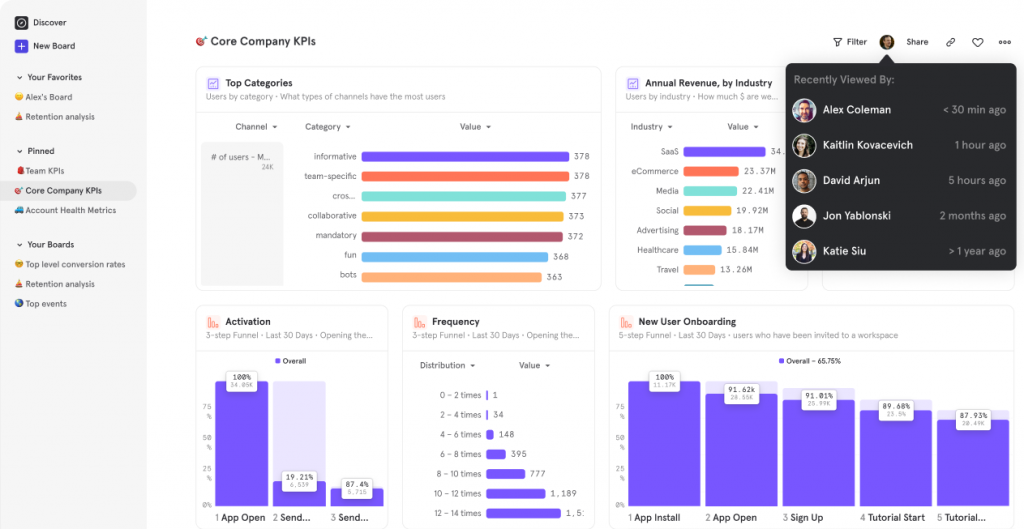
I’ve used Amplitude for a short period, and what I saw is that it excels at providing clear, actionable insights without needing extensive coding. The platform’s behavioral analytics and AI automation offer a powerful way to understand user behavior and optimize product performance.
Amplitude’s automated reports and real-time visualizations make it easy to grasp complex user journeys and identify key growth drivers. It’s particularly effective at highlighting significant trends and anomalies, allowing for data-driven decision-making and faster problem resolution. If you’re looking to enhance your product’s performance and streamline your analytics processes, Amplitude is a robust choice.
What You Will Like:
- Provides fast, clear answers to growth questions with automated reports.
- Offers instant visualizations of user journeys, helping you make data-driven decisions.
- Identifies key features and behaviors driving growth or churn with high accuracy.
- Uses AI to automate repetitive tasks and highlight significant trends and anomalies.
What You May Not Like:
- The initial setup and configuration might be complex for some users.
- Advanced features and scalability may come with higher pricing.
Pricing
Free plan available (Limited to starter templates only). The paid plan starts from $49/month
14. Asana – Best for Accelerating Campaign Production
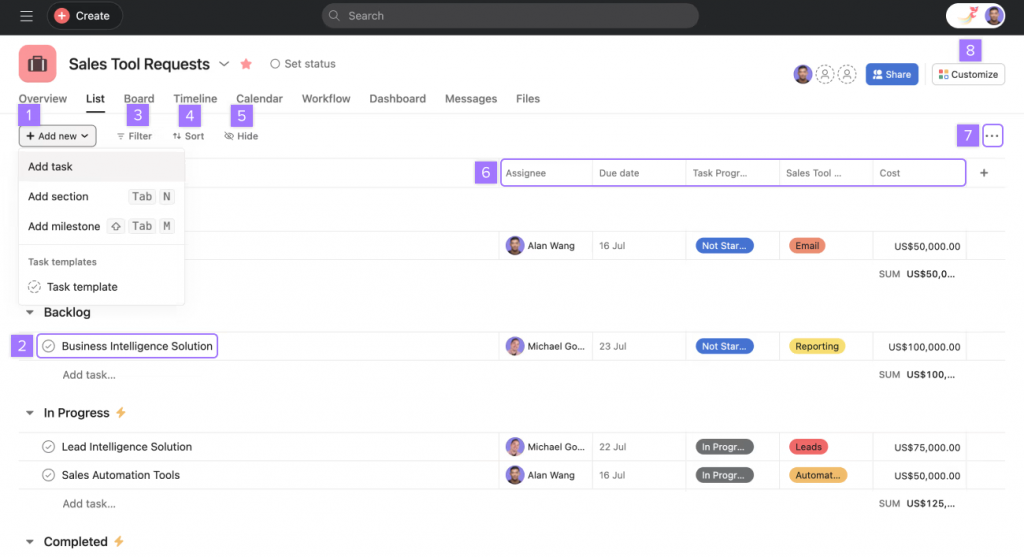
Asana’s 2025 Release is designed to change how marketing teams operate, aligning their work directly with revenue goals. This update enhances collaboration and speeds up campaign production, allowing teams to mobilize around clear objectives and maximize their resources.
Asana can handle many administrative functions, such as managing and assigning tasks to team members, scheduling deliverables, and collaborating in general. It also sends notifications for approaching deadlines and when new tasks are added or assigned.
What You’ll Like:
- Accelerate campaign production and enhance productivity.
- Use shared calendars and customizable dashboards to foster teamwork.
- Achieve up to 50% faster campaign production.
- Connect with over 270 apps, including Google Calendar and Salesforce.
What You May Not Like:
- Lacks functionality for tracking time spent on tasks.
- Each task can be assigned to only one person at a time.
Pricing
Free plan available (collaborate up to 10 teammates). The paid plan starts at US$10.99
15. BuzzSumo – Best for Competitor Intelligence
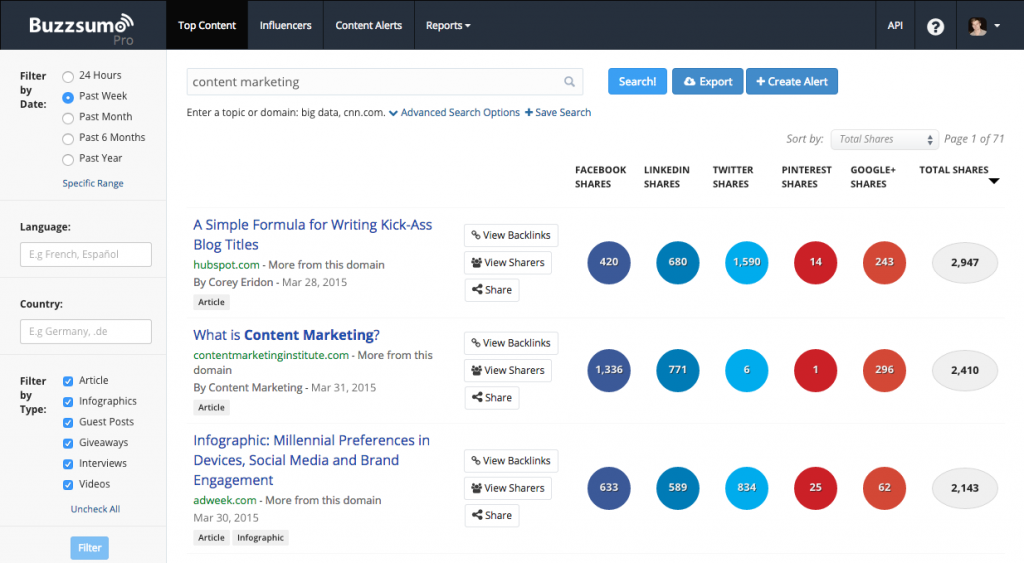
The last tool I’d like to add to this list is BuzzSumo, a comprehensive media database designed to offer deep insights into content creation and competitor strategies. BuzzSumo excels in enhancing your marketing efforts by providing detailed competitor analysis and content research capabilities. It enables you to understand what works in your industry by revealing the performance and engagement of competitors’ content.
The real-time monitoring feature alerts you to mentions and trends, allowing for swift reactions to market changes. Additionally, its advanced social analytics tool helps refine your strategies by offering detailed metrics and insights on audience preferences.
What You’ll Like:
- Use BuzzSumo’s data to develop and refine content strategies based on high-performing topics.
- Discover high-traffic keywords and trending topics to guide your content creation.
- Receive instant notifications about competitor mentions and market trends.
- Track detailed engagement metrics to optimize your campaigns based on audience behavior.
What You May Not Like:
- The interface can present a lot of information at once, which may be overwhelming for users trying to find specific insights.
- The pricing may be relatively high compared to the features offered.
Pricing
Custom quote
That wraps up our list of the best tools for product marketing catering to different purposes and budgets. We are sure you will find the right tool for your business if you assess your needs well.
FREE. All Features. FOREVER!
Try our Forever FREE account with all premium features!
How to Choose Product Marketing Tools
Choosing the right product marketing tools can feel like finding the perfect avocado—how do you know it’s just right? I’ve been there, juggling countless options, only to realize I could use guidance.
So, here’s what I suggest you always check when choosing product marketing tools. And hey, I’ll throw in some secret hacks, too—ones that are so uncommon most people overlook them!
The Basics: Your Tool Selection Checklist
Before we dive into the secret, let’s solidify your foundation. When evaluating a product marketing software, these core elements are non-negotiable:
- Integrations: Can it seamlessly connect with your existing tools, such as CRM, email marketing, and analytics platforms? A tool that doesn’t work well with others is a major red flag.
- Data-Driven Decisions: Does it offer robust analytics and reporting? You need hard data to prove your worth and optimize campaigns.
- Scalability: Will it grow with your business? You don’t want to outgrow your tool just as you’re hitting your stride.
- User Experience: Is it intuitive and enjoyable to use? A clunky tool will slow you down and frustrate your team.
- Value Proposition: Does the price align with the value it brings? Don’t overpay for features you won’t use.
Secret Hacks: Unconventional Wisdom for Tool Selection
Now, let’s get real. The basics are important, but it’s the unconventional thinking that sets you apart.
- Hidden Costs: Look beyond the price tag. Consider factors like implementation time, training requirements, and potential hidden fees. Some tools might seem cheap upfront but become costly in the long run.
- Vendor Lock-In: Evaluate how easy it is to switch to a different tool. You want to avoid being held hostage by a vendor.
- Data Privacy: Understand how the tool handles your data. In today’s data-driven world, data privacy is paramount.
- Customer Support Quality: Assess the level of support offered. A responsive and knowledgeable support team can be a lifesaver.
- Tool Philosophy Alignment: Does the tool’s approach to marketing align with your values and strategy? A tool that shares your vision will be a better fit.
Uncommon Considerations: Think Outside the Box
Let’s explore some often overlooked aspects of tool selection:
- Team Dynamics: Consider how the tool fits your team’s workflow and communication style.
- Future-Proofing: Look for tools that are adaptable and can accommodate emerging trends like AI and automation.
- Trial Period Utilization: Make the most of free trials by testing the tool under real-world conditions.
- Competitive Advantage: Can the tool help you differentiate your product and gain a competitive edge?
- Cultural Fit: Does the tool’s brand and values resonate with your company culture?
Remember, the perfect product marketing tool is out there. By considering these factors and going beyond the obvious, you’ll find the one that empowers you to achieve your marketing goals.
What is the Goal of Product Marketing Tools?
The primary goal of product marketing tools is to streamline and enhance the product marketing process. They aim to:
- Increase efficiency: Automate repetitive tasks and save time.
- Improve data-driven decision-making: Provide insights and analytics to inform marketing strategies.
- Enhance collaboration: Facilitate teamwork and communication between different departments.
- Boost productivity: Empower product marketers to focus on strategic initiatives.
What are the Benefits of Product Marketing Tools?
The benefits of product marketing tools are the positive outcomes derived from achieving these goals. They include:
- Faster time-to-market: Quickly launch and iterate on products.
- Improved product positioning: Better understand target audiences and tailor messaging accordingly.
- Increased sales and revenue: Drive product adoption and customer acquisition.
- Stronger brand reputation: Build a consistent brand image across all channels.
- Enhanced customer satisfaction: Deliver a better product experience through data-driven insights.
Also Read: Product Enhancements: Methods & Tips to Improve the Product | Qualaroo
What are the Key Features of Product Marketing Software?
When I’m on the hunt for the perfect marketing manager tools, I usually consider a bunch of features to make sure I’m getting the best bang for my buck.
Let me walk you through what I look for:
Customer Insights
I love tools that help me explore deep customer understanding. Targeted surveys and feedback analysis are my go-to methods to inform product strategy and messaging. It’s like being a mind reader but with less guesswork and more data.
Also Read: Customer Insight: Types, Benefits, Strategies, and Tools
Competitor Analysis
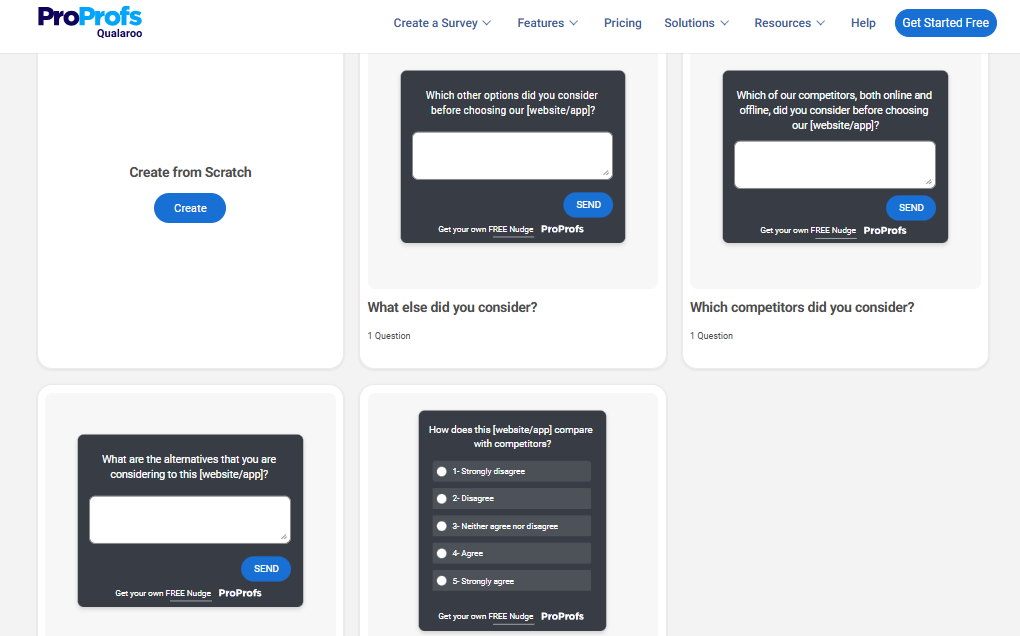
Identifying market gaps and refining product positioning for maximum impact keeps me ahead of the curve. Plus, who doesn’t enjoy a bit of friendly competition?
Product Launch Management
As you know, it’s important to streamline product launch planning, execution, and measurement for a successful market entry. Think of it as throwing a party—without the stress of running out of snacks. Everything needs to go off without a hitch!
Also Read: Using Qualaroo to Prioritize and Launch New Features
Marketing Automation
Automating repetitive tasks, personalizing customer journeys, and optimizing campaigns for efficiency and effectiveness is a lifesaver.
Analytics and Reporting
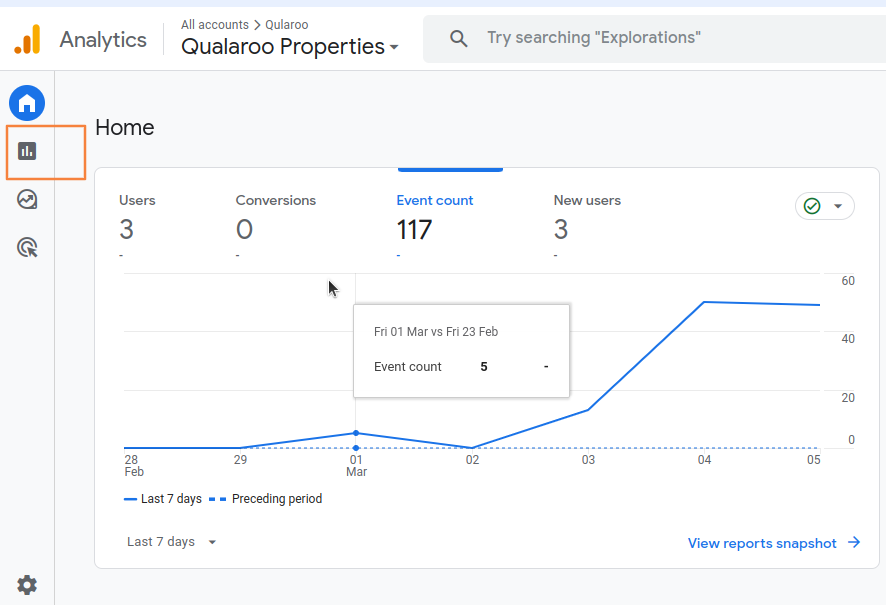
Measuring campaign performance, tracking key metrics, and gaining actionable insights to refine my strategy are my bread and butter. I mean, how else am I supposed to know if my brilliant ideas are working?
Customer Segmentation
Dividing my audience into distinct groups based on shared characteristics allows me to tailor my messaging and offers. It’s like being a matchmaker, ensuring every customer feels special.
Also Read: Customer Segmentation Analysis: Types, Examples, & Methods | Qualaroo
Pricing and Packaging Optimization
Analyzing pricing strategies, testing different packaging options, and optimizing revenue generation ensures you make the most of your money.
So, these are some of the features I keep an eye out for when choosing product marketing tools. They help me stay on top of my game, ensuring my strategies are sharp and my executions flawless.
FREE. All Features. FOREVER!
Try our Forever FREE account with all premium features!
How Do Product Marketing Tools Facilitate Collaboration Between Product and Marketing Teams?
Let’s dive into how product marketing tools facilitate collaboration between product and marketing teams. Then, I’ll share my personal experience using Qualaroo.
- Shared Dashboards for Real-Time Analytics: Product marketing tools provide shared dashboards where both teams can access real-time insights.
- Feedback Collection and Sharing: Tools like Qualaroo enable product marketing managers to collect feedback on products and digital assets. By sharing this feedback with the team, you can bridge the gap between product development and marketing.
- Streamlined Communication: Effective communication is essential for collaboration. Whether it’s through chat features or project management interfaces, these tools enhance collaboration.
- Automated Processes: Automation is a key aspect of collaboration. Product marketing tools automate recurring processes such as email marketing, chat support, and more.
Speaking from my own experience, I use Qualaroo to gather user feedback directly within our app. It helps me understand user pain points, preferences, and feature requests. By sharing this data with our marketing team, we align our messaging and campaigns with what truly matters to our users. Plus, Qualaroo’s real-time analytics keep us all on the same page, ensuring we make data-driven decisions.
Case study:

How Do Product Marketing Tools Help Teams Measure the Success of Their Campaigns?
Here are a few ways these tool help in measuring a campaign’s success:
Data Collection
First, these tools scoop up data from everywhere—social media, emails, websites, you name it. They track metrics like clicks, conversions, engagement levels, and customer feedback. It’s like having a detective who never sleeps, constantly gathering clues.
Real-Time Analytics
One of the coolest features is real-time analytics. Imagine having a dashboard that shows you live updates on how your campaign is doing. You can see ROI, customer acquisition costs, and lifetime value.
A/B Testing
Ever wondered which version of your email or landing page works best? With A/B testing, you can run experiments to compare two versions and see which one gets more love from your audience. It’s a bit like a scientific experiment but way more fun.
Also Read: What Is A/B Testing? Learn How It Boosts Website Performance (qualaroo.com)
Attribution Models
Attribution models are like your campaign’s GPS, showing you which touchpoints lead to conversions. They help you determine which channels and strategies drive results so you can focus on what works.
Segmentation and Personalization
Advanced segmentation lets you break down your audience into smaller, more targeted groups. The tools track how each segment responds to different campaign elements, making it easier to tailor your marketing strategies.
Integrated Marketing Automation
Automation is a game-changer. These tools can handle repetitive tasks like sending emails and posting on social media so that you can focus on the big picture. They even trigger actions based on user behavior, ensuring your communications are timely and relevant.
Conversion Tracking
Tracking conversions is crucial. These tools set up goals and events to measure how many users complete desired actions, like purchasing or filling out a form. It’s like having a scoreboard that shows you exactly how well you’re doing.
Also Read: The Beginner’s Guide to Conversion Rate Optimization
Integration with Other Tools
Product marketing tools often integrate with other business tools, such as Google Analytics, Salesforce, and HubSpot. This integration ensures a seamless data flow across platforms, giving you a holistic view of your campaign’s performance.
Feedback and Continuous Improvement
Finally, these tools collect and analyze customer feedback, helping you understand what works and doesn’t. This continuous feedback loop allows for iterative campaign improvements, improving them over time.
How Do You Identify and Target the Ideal Customers for a New Product?
When launching a new product, one of the most critical steps is identifying and targeting the ideal customers. Knowing your target audience ensures that your marketing efforts are effective and your product meets the right needs. Here’s how I go about it:
- First off, I conduct market research. This involves understanding the latest industry trends and keeping a close eye on competitors. One of the best ways to gather insights is by engaging directly with potential customers through surveys and interviews. For some inspiration as to what you should ask, read this blog.
- Next, I focus on defining the value proposition of the product. This step clearly articulates what makes the product unique and how it solves specific customer problems. Instead of just listing features, I usually highlight the unique benefits that set the product apart.
- Research your customer personas. I start by identifying basic demographics such as age, gender, income, and occupation. This helps me tailor marketing strategies that speak directly to the target audience.
- Segmenting the market comes next. This involves breaking down the larger market into smaller, more manageable segments based on behavior and geography. For instance, I might look at how often customers use similar products or where they are located.
- Data analytics plays a crucial role in this process. By analyzing existing customer data and market trends, I can find patterns and insights that inform marketing strategies. Tools and technologies that provide detailed analytics are invaluable here.
With all this information in hand, I then tailor marketing strategies to fit the identified segments and personas. The goal is to make the marketing efforts as relevant and engaging as possible.
Finally, the process involves testing and refining. I use A/B testing to experiment with different approaches and gather feedback to see what works best.
With these steps, I ensure that the new product reaches the right audience and effectively meets their needs. It’s all about being strategic, data-driven, and customer-focused.
Ready to Choose the Right Product Marketing Tool?
I’ve shared my top picks of the best product marketing tools based on real experiences and features that matter most. Whether you need in-depth feedback, easy survey creation, or comprehensive website analysis, there’s a tool that fits your needs.
Explore these options and find the perfect match for your business goals. Settle with the solution that propels your marketing strategy forward!
Frequently Asked Questions
How can product marketing tools help with launching a new product?
Product marketing tools streamline launch plans by organizing tasks, tracking progress, and managing campaigns. They provide insights into market trends and customer preferences, helping refine messaging and strategies for a successful launch.
How can product marketing tools help with launching a new product?
Recent trends include AI-powered analytics for deeper insights, automation for repetitive tasks, and integration with other marketing tools for a unified approach. Enhanced data visualization and real-time feedback mechanisms are also gaining popularity.
Can product marketing tools help with customer feedback?
Yes, these tools can collect and analyze customer feedback efficiently. They provide features to track reviews, survey responses, and social media comments, helping businesses understand customer needs and improve their products based on real insights.
FREE. All Features. FOREVER!
Try our Forever FREE account with all premium features!

 We'd love your feedback!
We'd love your feedback! Thanks for your feedback!
Thanks for your feedback!




